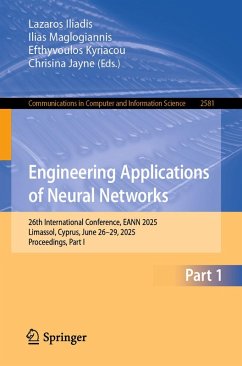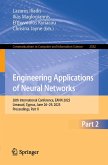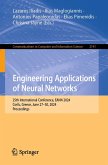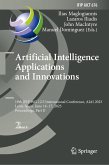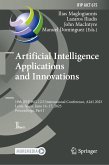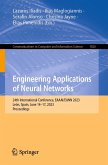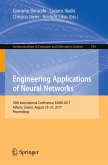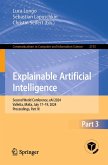Engineering Applications of Neural Networks (eBook, PDF)
26th International Conference, EANN 2025, Limassol, Cyprus, June 26-29, 2025, Proceedings, Part I
Redaktion: Iliadis, Lazaros; Jayne, Chrisina; Kyriacou, Efthyvoulos; Maglogiannis, Ilias
72,95 €
72,95 €
inkl. MwSt.
Sofort per Download lieferbar

36 °P sammeln
72,95 €
Als Download kaufen

72,95 €
inkl. MwSt.
Sofort per Download lieferbar

36 °P sammeln
Jetzt verschenken
Alle Infos zum eBook verschenken
72,95 €
inkl. MwSt.
Sofort per Download lieferbar
Alle Infos zum eBook verschenken

36 °P sammeln
Engineering Applications of Neural Networks (eBook, PDF)
26th International Conference, EANN 2025, Limassol, Cyprus, June 26-29, 2025, Proceedings, Part I
Redaktion: Iliadis, Lazaros; Jayne, Chrisina; Kyriacou, Efthyvoulos; Maglogiannis, Ilias
- Format: PDF
- Merkliste
- Auf die Merkliste
- Bewerten Bewerten
- Teilen
- Produkt teilen
- Produkterinnerung
- Produkterinnerung

Bitte loggen Sie sich zunächst in Ihr Kundenkonto ein oder registrieren Sie sich bei
bücher.de, um das eBook-Abo tolino select nutzen zu können.
Hier können Sie sich einloggen
Hier können Sie sich einloggen
Sie sind bereits eingeloggt. Klicken Sie auf 2. tolino select Abo, um fortzufahren.

Bitte loggen Sie sich zunächst in Ihr Kundenkonto ein oder registrieren Sie sich bei bücher.de, um das eBook-Abo tolino select nutzen zu können.
The two-volume set CCIS 2581 and 2582 constitutes the refereed proceedings of the 26th International Conference on Engineering Applications of Neural Networks, EANN 2025, held in Limassol, Cyprus during June 26-29, 2025.
The 41 full papers included in these proceedings were carefully reviewed and selected from 101 submissions. These papers demonstrate the vitality of Artificial Intelligence algorithms and approaches, as well as AI applications.
- Geräte: PC
- ohne Kopierschutz
- eBook Hilfe
- Größe: 31.55MB
Andere Kunden interessierten sich auch für
![Engineering Applications of Neural Networks (eBook, PDF) Engineering Applications of Neural Networks (eBook, PDF)]() Engineering Applications of Neural Networks (eBook, PDF)72,95 €
Engineering Applications of Neural Networks (eBook, PDF)72,95 €![Engineering Applications of Neural Networks (eBook, PDF) Engineering Applications of Neural Networks (eBook, PDF)]() Engineering Applications of Neural Networks (eBook, PDF)72,95 €
Engineering Applications of Neural Networks (eBook, PDF)72,95 €![Artificial Intelligence Applications and Innovations (eBook, PDF) Artificial Intelligence Applications and Innovations (eBook, PDF)]() Artificial Intelligence Applications and Innovations (eBook, PDF)104,95 €
Artificial Intelligence Applications and Innovations (eBook, PDF)104,95 €![Artificial Intelligence Applications and Innovations (eBook, PDF) Artificial Intelligence Applications and Innovations (eBook, PDF)]() Artificial Intelligence Applications and Innovations (eBook, PDF)104,95 €
Artificial Intelligence Applications and Innovations (eBook, PDF)104,95 €![Engineering Applications of Neural Networks (eBook, PDF) Engineering Applications of Neural Networks (eBook, PDF)]() Engineering Applications of Neural Networks (eBook, PDF)72,95 €
Engineering Applications of Neural Networks (eBook, PDF)72,95 €![Engineering Applications of Neural Networks (eBook, PDF) Engineering Applications of Neural Networks (eBook, PDF)]() Engineering Applications of Neural Networks (eBook, PDF)72,95 €
Engineering Applications of Neural Networks (eBook, PDF)72,95 €![Explainable Artificial Intelligence (eBook, PDF) Explainable Artificial Intelligence (eBook, PDF)]() Explainable Artificial Intelligence (eBook, PDF)64,95 €
Explainable Artificial Intelligence (eBook, PDF)64,95 €-
-
-
The two-volume set CCIS 2581 and 2582 constitutes the refereed proceedings of the 26th International Conference on Engineering Applications of Neural Networks, EANN 2025, held in Limassol, Cyprus during June 26-29, 2025.
The 41 full papers included in these proceedings were carefully reviewed and selected from 101 submissions. These papers demonstrate the vitality of Artificial Intelligence algorithms and approaches, as well as AI applications.
The 41 full papers included in these proceedings were carefully reviewed and selected from 101 submissions. These papers demonstrate the vitality of Artificial Intelligence algorithms and approaches, as well as AI applications.
Dieser Download kann aus rechtlichen Gründen nur mit Rechnungsadresse in A, B, BG, CY, CZ, D, DK, EW, E, FIN, F, GR, HR, H, IRL, I, LT, L, LR, M, NL, PL, P, R, S, SLO, SK ausgeliefert werden.
Produktdetails
- Produktdetails
- Verlag: Springer International Publishing
- Seitenzahl: 283
- Erscheinungstermin: 21. Juni 2025
- Englisch
- ISBN-13: 9783031961960
- Artikelnr.: 74623145
- Verlag: Springer International Publishing
- Seitenzahl: 283
- Erscheinungstermin: 21. Juni 2025
- Englisch
- ISBN-13: 9783031961960
- Artikelnr.: 74623145
- Herstellerkennzeichnung Die Herstellerinformationen sind derzeit nicht verfügbar.
.- A Real-Time Human Action Recognition Model for Assisted Living.
.- A Survey of Federated Learning-Based Intrusion Detection Methods in Medical IoT
.- AI-based automatic counting and classification of aedes mosquito eggs in field traps.
.- An Empirical Review of Uncertainty Estimation for Quality Control in CAD Model Segmentation.
.- Brain Inspired Learning for Neural Networks.
.- Comparative Analysis of Machine Learning Techniques for Chronic Kidney Disease Prediction Efficiency.
.- Detecting Anomalous Self-Citations using Citation Network Analysis and LLMs.
.- Early Detection of Voice Pathology from Cry Analysis Using Non-Interpretable Features and Parallel 1D CNN.
.- Easy, Fast and Reliable Modulo and Linear Congruential Generator Approximation with Artificial Neural Networks.
.- EEG-based Hybrid Emotion Recognition Model with Statistical-Wavelet Features and Modality-Agnostic Loss.
.- ESN with delayed inputs to model industrial processes.
.- Exploring Knowledge Distillation for Model Compression in Edge Environments.
.- Exploring Various Sequential Learning Methods for Deformation History Modeling.
.- FusionNet:Leveraging Dual Speech Separation Networks for Enhanced Multi-Speaker Isolation.
.- Hybrid Deep Learning and Gradient Boosting for Superior Sentiment Analysis: A Comparative Study.
.- Implementing Hybrid Tsetlin Machine and Q-Learning for Solving the Job Shop Scheduling.
.- Maximum Interstory Drift Ratio (MIDR) equations for R/C buildings using machine learning procedures.
.- MRI-Based Brain Tumor Classification Using Ensemble CNN, VGG16, and ResNet50 Model.
.- Needle-in-the-Haystack Testing LLMs with a Complex Reasoning Task.
.- Utilizing Multiple Data Sources to Improve Prediction of Severe Weather Events through Spatio-Temporal Analysis.
.- A Survey of Federated Learning-Based Intrusion Detection Methods in Medical IoT
.- AI-based automatic counting and classification of aedes mosquito eggs in field traps.
.- An Empirical Review of Uncertainty Estimation for Quality Control in CAD Model Segmentation.
.- Brain Inspired Learning for Neural Networks.
.- Comparative Analysis of Machine Learning Techniques for Chronic Kidney Disease Prediction Efficiency.
.- Detecting Anomalous Self-Citations using Citation Network Analysis and LLMs.
.- Early Detection of Voice Pathology from Cry Analysis Using Non-Interpretable Features and Parallel 1D CNN.
.- Easy, Fast and Reliable Modulo and Linear Congruential Generator Approximation with Artificial Neural Networks.
.- EEG-based Hybrid Emotion Recognition Model with Statistical-Wavelet Features and Modality-Agnostic Loss.
.- ESN with delayed inputs to model industrial processes.
.- Exploring Knowledge Distillation for Model Compression in Edge Environments.
.- Exploring Various Sequential Learning Methods for Deformation History Modeling.
.- FusionNet:Leveraging Dual Speech Separation Networks for Enhanced Multi-Speaker Isolation.
.- Hybrid Deep Learning and Gradient Boosting for Superior Sentiment Analysis: A Comparative Study.
.- Implementing Hybrid Tsetlin Machine and Q-Learning for Solving the Job Shop Scheduling.
.- Maximum Interstory Drift Ratio (MIDR) equations for R/C buildings using machine learning procedures.
.- MRI-Based Brain Tumor Classification Using Ensemble CNN, VGG16, and ResNet50 Model.
.- Needle-in-the-Haystack Testing LLMs with a Complex Reasoning Task.
.- Utilizing Multiple Data Sources to Improve Prediction of Severe Weather Events through Spatio-Temporal Analysis.
.- A Real-Time Human Action Recognition Model for Assisted Living.
.- A Survey of Federated Learning-Based Intrusion Detection Methods in Medical IoT
.- AI-based automatic counting and classification of aedes mosquito eggs in field traps.
.- An Empirical Review of Uncertainty Estimation for Quality Control in CAD Model Segmentation.
.- Brain Inspired Learning for Neural Networks.
.- Comparative Analysis of Machine Learning Techniques for Chronic Kidney Disease Prediction Efficiency.
.- Detecting Anomalous Self-Citations using Citation Network Analysis and LLMs.
.- Early Detection of Voice Pathology from Cry Analysis Using Non-Interpretable Features and Parallel 1D CNN.
.- Easy, Fast and Reliable Modulo and Linear Congruential Generator Approximation with Artificial Neural Networks.
.- EEG-based Hybrid Emotion Recognition Model with Statistical-Wavelet Features and Modality-Agnostic Loss.
.- ESN with delayed inputs to model industrial processes.
.- Exploring Knowledge Distillation for Model Compression in Edge Environments.
.- Exploring Various Sequential Learning Methods for Deformation History Modeling.
.- FusionNet:Leveraging Dual Speech Separation Networks for Enhanced Multi-Speaker Isolation.
.- Hybrid Deep Learning and Gradient Boosting for Superior Sentiment Analysis: A Comparative Study.
.- Implementing Hybrid Tsetlin Machine and Q-Learning for Solving the Job Shop Scheduling.
.- Maximum Interstory Drift Ratio (MIDR) equations for R/C buildings using machine learning procedures.
.- MRI-Based Brain Tumor Classification Using Ensemble CNN, VGG16, and ResNet50 Model.
.- Needle-in-the-Haystack Testing LLMs with a Complex Reasoning Task.
.- Utilizing Multiple Data Sources to Improve Prediction of Severe Weather Events through Spatio-Temporal Analysis.
.- A Survey of Federated Learning-Based Intrusion Detection Methods in Medical IoT
.- AI-based automatic counting and classification of aedes mosquito eggs in field traps.
.- An Empirical Review of Uncertainty Estimation for Quality Control in CAD Model Segmentation.
.- Brain Inspired Learning for Neural Networks.
.- Comparative Analysis of Machine Learning Techniques for Chronic Kidney Disease Prediction Efficiency.
.- Detecting Anomalous Self-Citations using Citation Network Analysis and LLMs.
.- Early Detection of Voice Pathology from Cry Analysis Using Non-Interpretable Features and Parallel 1D CNN.
.- Easy, Fast and Reliable Modulo and Linear Congruential Generator Approximation with Artificial Neural Networks.
.- EEG-based Hybrid Emotion Recognition Model with Statistical-Wavelet Features and Modality-Agnostic Loss.
.- ESN with delayed inputs to model industrial processes.
.- Exploring Knowledge Distillation for Model Compression in Edge Environments.
.- Exploring Various Sequential Learning Methods for Deformation History Modeling.
.- FusionNet:Leveraging Dual Speech Separation Networks for Enhanced Multi-Speaker Isolation.
.- Hybrid Deep Learning and Gradient Boosting for Superior Sentiment Analysis: A Comparative Study.
.- Implementing Hybrid Tsetlin Machine and Q-Learning for Solving the Job Shop Scheduling.
.- Maximum Interstory Drift Ratio (MIDR) equations for R/C buildings using machine learning procedures.
.- MRI-Based Brain Tumor Classification Using Ensemble CNN, VGG16, and ResNet50 Model.
.- Needle-in-the-Haystack Testing LLMs with a Complex Reasoning Task.
.- Utilizing Multiple Data Sources to Improve Prediction of Severe Weather Events through Spatio-Temporal Analysis.
